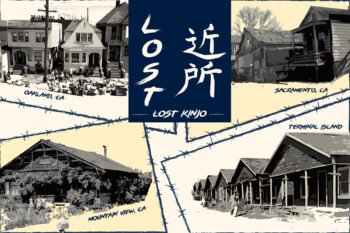By Jana Monji, AsAmNews Arts & Culture Writer
After a long weekend avoiding movies and, instead, focusing on the revival of San Diego Comic-Con (Special Edition), I slipped into a screening of Licorice Pizza to verify rumors of casual racism. The film has nothing to do with pizza, or the chain by that name. It’s about a very tall 15-year-old boy Gary Valentine (Cooper Hoffman) who develops a questionable crush on a 25-year-old woman, Alana Kane (Alana Haim), when he meets her in line waiting to have his yearbook photo taken at Grant High School in 1973.
For Alana, working for the school photography outfit, Tiny Toes, is a dead end job. For Gary, every moment is a chance to promote himself, but he is in the midst of re-creation. He was once a child actor, but he’s too tall and sturdily built to be cute. Instead, he’s cheerfully chubby and no where near hunky. To me, this is on the edge of creepy. Would we find this as amusing if the former child actor was a 15-year-old girl pursuing a twenty-some loser man?
The whole romance between these two has nothing to do with the two Japanese women who appear briefly. The two Japanese women, Mioko (Yumi Mizui) and Kimiko (Megumi Anjo), could easily have been deleted from the script. Their dialogue is in Japanese, but there are no subtitles to translate what they are saying. The non-Japanese speaking audience has to rely upon what the husband Jerry Frick (John Michael Higgins), says in English. That would be okay, but Higgins’ Jerry goes one step further: He speaks English momentarily in a fake Japanese accent.
Unless you’ve been to Japan and possibly participated in the JET program, you might not be aware that the Japanese public education system requires reading and listening comprehension of English, usually American English. The Frick character claims to have run a restaurant in Japan for 15 years. It would be amazing to have lived in Japan for 15 years and speak no Japanese, particularly when one is married to a Japanese national who seems to only speak Japanese (at least for the purposes of the film).
LATEST STORIES
The only purpose for the Japanese women is to set up a joke. The protagonist, Gary Valentine, can’t tell the difference between wife number one (Mioko) and wife number two (Kimiko). For Jerry, they seem to be just as interchangeable and expendable. While the credits list another clearly Asian American actor, Sung Han, as Fat Bernie’s Pinball Crowd, there is no fully developed character of East Asian descent. The audience has no investment in any of these characters.
This usage of untranslated non-English dialogue in Licorice Pizza differs from Steven Spielberg’s West Side Story. In that film, the Puerto Rican characters have part of their conversations in Spanish and the audience isn’t provided with subtitles. Yet, we get to know all of these characters and they are delineated and important to the plot.
Further, even the Polish American gang members in the 1961 film use some Spanish phrases to provoke and mock their Puerto Rican rivals. The Frick character in Licorice Pizza doesn’t use Japanese gairaigo (外来語 or words adopted from outside of Japan and brought into Japanese). For instance, the Japanese pronunciation for the word “cake” is two syllables (ケーキ) or the Japanese pronunciation for the word “milk” is three syllables (ミルク).
In a bilingual environment, one might expect someone code-switching between languages or substituting nouns (e.g. Genki 元気 for healthy) or hedge words (e.g. Chotto ちょっと) when communicating with someone in Japanese or adding particles that demonstrate agreement (e.g. ne as in ii desu ne 良いですね). That isn’t what happens here in Paul Thomas Anderson’s script.
The dialogue where Frick, instead of approximating a fusion of Japanese and English, relies on a fake East Asian accent doesn’t really rise to parody. It just seems sloppy and lazy.
In some ways, the background color supplied by the two Japanese wives of the Frick character is not so far from the way the cult classic TV series Firefly used East Asian culture. In that universe, supposedly there is a fusion between Western and East Asian cultures and due to a Sino-American Alliance, Mandarin Chinese is a common language, but you don’t hear it creeping into the dialogue convincingly and none of the main characters are Chinese. Similarly, “Blade Runner” used a lot of East Asian visuals, but none of the main characters was of East Asian descent. This is East Asian culture as background exotica.

In Licorice Pizza, there is no notion of East Asian cultures fusing within the San Fernando Valley. Frick runs a restaurant and knows Gary Valentine because he uses Valentine’s mother’s agency for advertising. Frick is based on a real person (Jerome Frick) who was married to a woman named Yoko when he met a married woman named Hiroko in 1966 at the Mikado Hotel and Restaurant which was owned and operated by Jerome and his then-wife Yoko.
According to legal proceedings, Yoko sued for divorce in 1968. Jerome acquired her interests in the Midako. He married Hiroko in 1971 (23 November) after her divorce from her then-husband was entered into judgment (May 1971). Jerome filed for divorce in 1983. In the divorce proceedings between Jerome and Hiroko, “the court found Hiroko to be a person of above average intelligence and good health with a fluency in two languages–English and Japanese.”
Whether or not Jerome Frick really spoke in a fake Japanese accent to either of his wives, I do not know. Anderson skewers other well known people such as William Holden (Sean Penn as a drunken Jack Holden), Jon Peters (Bradley Cooper), Joel Wachs (Benny Safdie), Lucy Doolittle (Christine Ebersole as an actress based on Lucille Ball) and Fred Gwynne (John C. Reilly). Yet these are people we know and have some kind of character development with in the film.
The Japanese wives are portrayed in Licorice Pizza as expendable and interchangeable East Asians. That’s nothing new for the US film industry or a culture that sometimes maintains East Asians all look alike. I wonder if Anderson felt compelled to include these women as part of proof of diversity. In which case, that’s just a facade of diversity instead of the real deal. This seems like a slice of casual racism and I’m not buying it.
AsAmNews has Asian America in its heart. We’re an all-volunteer effort of dedicated staff and interns. Check out our new Instagram account. Go to our Twitter feed and Facebook page for more content. Please consider interning, joining our staff, or submitting a story, or making a contribution.









